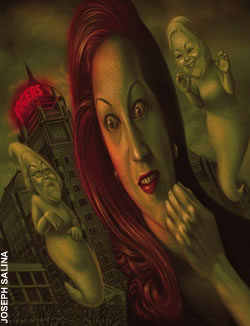Anatomy of a Libel
Mark McQueen versus the National Post—no one leaves the room smiling
We hardly ever read about the details of libel suits. Public silence about these cases, and any monetary awards, are most often part of a settlement agreement. Both parties usually stay quiet about the facts. So it’s unusual that McQueen is willing to share his side of the story, and it’s not so unusual that Tedesco has declined to comment, stating in an email that she is bound by legal constraints. But here, we are able to dissect libel law in Canada and question how well it works for the parties involved.
Perched up 31 floors in the Orion Securities offices (formerly Yorkton Securities) in downtown Toronto, McQueen describes his drama. The cast includes: Yorkton’s chief executive, Scott Paterson; Piergiorgio Donnini, then the brokerage firm’s head trader; and McQueen himself, then managing director of investment banking. (McQueen stayed with the firm during its name change, but as of 2005 had moved to Wellington Financial as president and CEO.)
On February 29, 2000, Paterson’s glass-walled office was the scene for what was to become one of the biggest scandals on Bay Street in years. That day, during what seemed a normal meeting, McQueen witnessed Paterson leak crucial refinancing details concerning their client, Kasten Chase Applied Research Ltd., to head trader Donnini. By March 2002, McQueen had attended two voluntary interviews initiated by the Ontario Securities Commission (OSC), the body that administers and enforces securities legislation, regarding the incident. Sometime during the second week of May, Tedesco received a copy of McQueen’s confidential OSC interview transcripts. These became the basis for her May 13, 2002, story, “Final Act of Yorkton Drama.”
The phone call McQueen received from Tedesco on the evening of May 12, 2002, was puzzling. By that hour, he knew the next day’s paper would have already been put to bed. But he also knew the story was hot and wasn’t surprised the Post was covering it. His upcoming testimony at the OSC hearing was the talk of Bay Street – it was highly unusual for an employee to testify against a colleague for insider trading.
What puzzled McQueen was that Tedesco hadn’t asked him for comment. Rather, he says, she carefully explained to him that she wanted him to be able to deny having any role in the production of her story. McQueen’s father was prominent journalist Rod McQueen, a former Post reporter, and Mark was uncomfortable with the tone of the conversation. “It was the third time she said, ‘I hope you understand,’ that I realized I was going to have the wood taken to me,” he says.
On May 13, McQueen awoke at 4 A.M. and waited for the paper to arrive. “Three hours later, I find out this whole thing is my fault, allegedly.” A small head-shot of him stared back from the front page of the Financial Post section of the Post, accompanied by Tedesco’s news story about the OSC case, which ran next to her longer story. After reading the second piece, McQueen felt he was the primary target. There were two parts of the story that angered him, both of which appeared on page seven of the Financial Post. The first read: “For the most part, sources say, they have repeated what they’d already said [in previous interviews]. Except for Mr. McQueen. Under examination by OSC staff on Feb. 11, 2002, he appeared to do the unthinkable… Mr. McQueen appeared to contradict – and therefore expose himself by giving a different version of some of the most salient testimony he had given five months earlier.”
To McQueen, she might as well have just called him a liar outright. In the second part, Tedesco wrote: “If he had acted accordingly, perhaps the whole messy imbroglio could have been avoided.”
McQueen couldn’t believe what he was reading. “To be actually accused of being the source of the problem and a liar just struck at my core – and started a two-year odyssey.”
Libel is a common-law based legal cause of action that judges interpret on a case-by-case basis. It deals with written or visual work that is in permanent form, while slander focuses on the spoken word. The documentation of television programs means they fall under the libel legislation, and television and radio broadcasts are treated as libel. The provincial libel and slander acts give journalists some protection, including the requirement of written notice for any libel prior to the lawsuit (which applies in every province except B.C.). The law defines defamation as a “statement which tends to lower a person in the estimation of right thinking members of society” – in other words, a statement that tends to harm an individual’s reputation. If an individual feels defamed, he or she can request a retraction, clarification, or apology. Often the request takes the form of a libel notice, which is required by the legislation. Libel litigation can be costly, but the potential award for general and actual damages can be in the hundreds of thousands of dollars.
There is no guarantee, though. If the case is lost, the plaintiff is responsible for covering his or her legal fees, and sometimes the defendant’s. Risky as it is, a civil lawsuit is the only option the law provides.
The same day his face graced page one of the Financial Post, McQueen left a voice message for Tedesco. When she returned his phone call, McQueen told her that she had used select quotations, and that “had one read the whole transcript, one would realize the story was wrong.” The OSC transcript was about 500 pages long, and McQueen had his own copy. He faxed the seven pages he believed were important in getting his point across to Tedesco. Neither McQueen nor the OSC had provided copies earlier to the Post.
After receiving McQueen’s faxed excerpts from the transcript, which she had originally received in the second week of May, Tedesco, an experienced reporter, stood her ground. She and McQueen spoke twice by telephone that day, but both remained convinced they were in the right. John Ivison, Tedesco’s editor at the time, supported Tedesco’s assertion that her article was accurate. This wasn’t unusual, since he had worked with her on the story and obviously believed it was right – otherwise, it would not have been published.
In Ontario, the person who wants to sue a media outlet for defamation must serve notice within six weeks of the piece coming to his or her attention. When the outlet, which must publish at least 12 times a year, receives notice, it has a choice: if it publishes a fair and full retraction within three days, in a place as prominent as the article in question, the lawsuit usually (but not always) goes away, as the claim for damages has, in most cases, been drastically limited. Or, the publication and the plaintiff in question decide to fight it out in court. Libel remains one of the few laws where the main burden of proof lies with the defence – the plaintiff is not responsible for proving any defamatory statements false. Instead, defamatory statements are assumed false until proven otherwise. In McQueen’s case, the Post refused to publish any kind of correction.
Two days after the story ran, McQueen filed his libel notice. He hired litigation lawyer Jonathan Stainsby of Heenan Blaikie to take on the Post. He knew it might be tough, but he began the battle with a sense of optimism, sure the law was on his side. “In libel,” he remarked, “you can’t be half right – you have to be all right.”
After months of delay, discovery began in April 2003. It lasted five months, during which time each party was examined under oath and had to disclose documents relating to issues in the litigation. Legal bills in the tens of thousands of dollars made their way into the McQueen mailbox. It was an arduous process. McQueen says he felt frustrated. It was unclear when or if the trial would begin.
Then things got even more difficult. He felt pressured to drop the case. It wasn’t easy to sue one of the two major papers (the other being The Globe and Mail) that cover one’s place of employment. He was looking at weeks of his life being consumed by the trial. McQueen began to wonder if he was being selfish. He was placing considerable strain on his family, spending loads of cash, and, now, jeopardizing his job with potential negative publicity. “Is a 25-year career worth putting on the rocks over a few simple words?” he remembers asking himself. He felt it was his reputation and good name were at stake.
Of course, both parties in a libel case tend to feel that way, which is why cases can become time-consuming and expensive. A publication relies on its reputation for fair and honest reporting and will go to the wall to protect it – when it believes it is in the right and, sometimes, even when it’s in the wrong. In some of Canada’s major libel cases, that’s exactly what happened. In 1981, the Toronto Sun published a story linking former federal cabinet minister John Munro to the purchase and sale of Petrofina shares, prior to the company being taken over by the federal government. Munro denied playing any role in any insider trading scam and launched a libel suit. When the Sun investigated, the reporters could not produce the documents they said they had. The editors’ published apology verified they had not examined their reporter’s documents in detail. Munro was awarded $75,000 in damages.
A case against the fifth estate resulted in one of Canada’s highest damage awards under libel law. An episode entitled “Heart of the Matter” featured an interview with hypertension specialist Dr. Frans Leenen, the chair of a committee examining a class of drugs regarding the safety and usage of the calcium channel blocker nifedipine, a heart medication. In particular, the committee looked at whether or not, in high dosages, the drug could be dangerous to people with heart disease. The committee sent a letter to physicians outlining proper prescribing practices for the drug. In two separate cases, one decided in Toronto and one in Ottawa, the court found that CBC failed to accurately reflect Dr. Leenan and cardiologist Dr. Martin Myers’s views, and made them out to be “bad guys” who may have had conflicts of interest because of ties to drug manufacturers. In 1999, Leenen was awarded $950,000 in general, aggravated, and punitive damages, and in 2000, Myers was awarded $350,000 in personal damages. The court’s finding of malice in the two separate cases made it impossible for CBC to raise technical objections to the decisions of the two judges in the Supreme Court of Canada.
The media, of course, are not always in the wrong, nor are they always the party with the most resources. The threat of costly and lengthy defamation trials hangs like a dark cloud over smaller publications. Jeremy Nelson, publisher of the Peer Review, a University of Toronto-based magazine for graduate students, says libel laws create a competitive disadvantage. “The high cost of defamation insurance and deductibles means that only the largest publications can afford it,” he says. “One error can mean the end for an independent publication.” Nelson says the law should be changed. “Libel laws are another barrier to the sustainability of new publications, and that is detrimental to free expression, not to mention the growth of the industry as a whole.”
As it is currently applied, libel law may scare journalists and publications away from doing important stories because of the real threat of a lawsuit – a phenomenon known as “libel chill.” If the current cold front in Canada can be attributed to any one case, it’s the Reichmanns versus Toronto Life in the late 1980s.
In her 1992 book, Bound and Gagged: Libel Chill and the Right to Publish, journalist Kimberley Noble reported that the Reichmanns, one of Canada’s wealthiest families, spent an estimated $3 million to $4 million on private detectives to dissect Elaine Dewar’s November 1987 Toronto Life feature about the family’s business dealings in Europe and Africa during the Second World War. After almost three years of pretrial dealings, the Reichmanns settled out of court (Toronto Life had exhausted its libel insurance before trial proceedings could begin). The magazine published a full-page apology in its March 1991 edition.
McQueen, Munro, and Leenen all had the resources to continue pursuing their cases. “The reason no one sues in Canada,” McQueen shrugs, “is because it is a very expensive process – $200,000 to $400,000 – so unless your name is Reichmann or Black, you don’t challenge the media.” Canada continues to “wallow in collective complacency,” wrote Noble. She noted in her book that, under existing law, all a plaintiff needs is to be offended and wealthy to get a libel suit underway.
Noble knows this firsthand. In late 1986, she was assigned to cover the Edper group of companies for theGlobe. According to Noble, Edper sent several letters to the paper claiming either that information in Noble’s articles was false or was written with malicious intent. She says she and the Globe were threatened several times with legal action.
Nothing much has changed since Bound and Gagged was published, Noble says now. “Our laws are outdated. Efforts to reform legislation to reflect modern-day realities keep foundering, due to opposition from senior civil servants and legislative agendas that get swamped with other more pressing issues.” But financial resources should have no weight in the pursuit of justice, Noble insists. “It’s still easy to use the laws here simply as a weapon. The person with the deepest pockets still wins.” The result is not just libel chill, but damage to the democratic commitment of journalism to tell hard truths and to hold the powerful to account. “We have become like the frogs in hot water,” says Noble. “We are so accustomed to not writing certain stories about certain people that we forget it was something we used to want to do.”
Neither scenario, from the perspective of the unfairly portrayed subject, or the silenced journalist, seems to result in satisfaction with the law – even when it works. In theory, McQueen eventually got what he wanted. The parties settled before trial, and on June 2, 2004 the Post ran an apology on page two of the Financial Post. It stated: “The National Post apologizes for any damage or embarrassment caused to Mr. McQueen’s professional reputation and personal character as a result of this article.” There is no mention of Tedesco apologizing, or acquiescing, in the settlement.
To this day, no one has admitted to any liability. Jonathan Harris, current executive editor at the Post, says the paper made no material errors in the May 13, 2002 story, stating in an email: “The National Post only apologized for any misunderstanding in case some readers may have attributed to the story the meaning that Mr. McQueen attributed to it.”
The Post wrote McQueen a cheque for $279,767.56, of which approximately $60,000 covered damages, and the rest his legal costs. For him, the outcome is bittersweet – a late apology from the paper, and some spare cash. He risked a lot, and his legal bills were just over $250,000, including $30,000 the Post had already picked up. The sentiment he’s left with says it all: “This law is an ass.”
Mary Findlater was the Director of Advertising for the Spring 2005 issue of the Ryerson Review of Journalism.














































Pingback: Legal issues in mass media for paula hog - Superb Essay